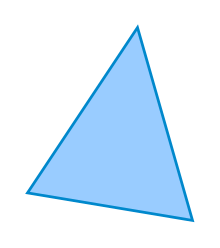Triangle Area
| Triangle | |
|---|---|

A triangle
|
|
| Edges and vertices | 3 |
| Schläfli symbol | {3} (for equilateral) |
| Area | various methods; see below |
| Internal angle (degrees) | 60° (for equilateral) |
A triangle is a polygon with three edges and three vertices. It is one of the basic shapes in geometry. A triangle with vertices A, B, and C is denoted .
In Euclidean geometry any three points, when non-, determine a unique triangle and simultaneously, a unique plane (i.e. a two-dimensional Euclidean space), in other words, there is only one plane that contains that triangle and every triangle is contained in some plane. If the entire geometry is only the Euclidean plane, there is only one plane and all triangles are contained in it, however, in higher dimensional Euclidean spaces this is no longer true. This article is about triangles in Euclidean geometry, and, in particular, the Euclidean plane, except where otherwise noted.
Triangles can be classified according to the lengths of their sides:
Hatch marks, also called tick marks, are used in diagrams of triangles and other geometric figures to identify sides of equal lengths. A side can be marked with a pattern of "ticks", short line segments in the form of tally marks; two sides have equal lengths if they are both marked with the same pattern. In a triangle, the pattern is usually no more than 3 ticks. An equilateral triangle has the same pattern on all 3 sides, an isosceles triangle has the same pattern on just 2 sides, and a scalene triangle has different patterns on all sides since no sides are equal. Similarly, patterns of 1, 2, or 3 concentric arcs inside the angles are used to indicate equal angles. An equilateral triangle has the same pattern on all 3 angles, an isosceles triangle has the same pattern on just 2 angles, and a scalene triangle has different patterns on all angles since no angles are equal.
...
Wikipedia

